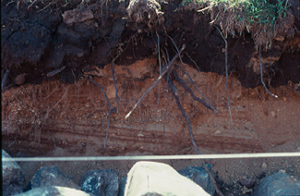Home > Site analysis > Evaluate below-ground characteristics > Artificial soil horizons
Artificial soil horizons
 Sharp boundaries in the soil may indicate a water drainage problem. Note how roots often grow best in the top layer. Click on picture to see larger image. |
Most soils in urban areas and many suburban landscapes are disturbed with heavy machinery before trees are planted. Poor quality subsoil with a fine texture or high clay content often is brought to the surface or used as fill soil.
Construction debris and other soils are often layered on top of one another creating an artificial soil profile, or horizon. This layering of dissimilar soil types keeps it unusually wet by disrupting the natural percolation of water.
Suspect a water percolation problem if there are sharp boundaries between different soil types. This is often indicated by distinct differences in soil color (picture on right). It is often best to mix different soil layers together with a rototill or other device.
See: Potential site modifications for solutions to this type of problem.

